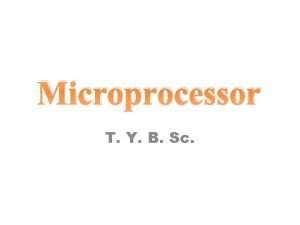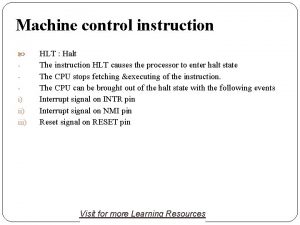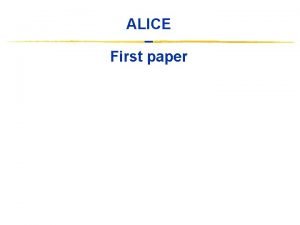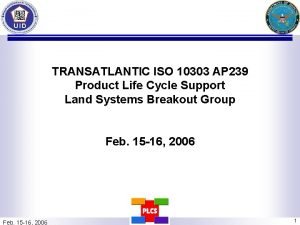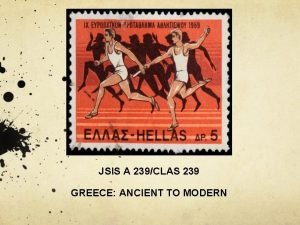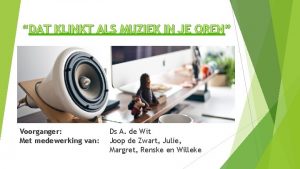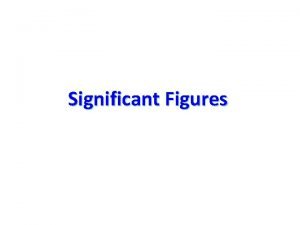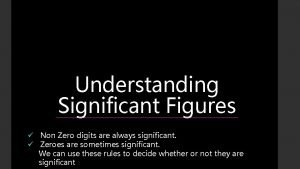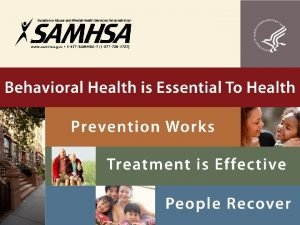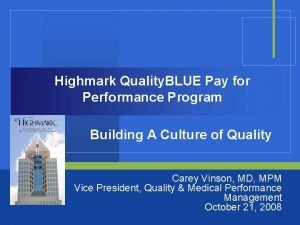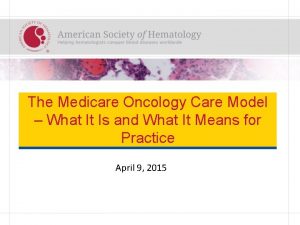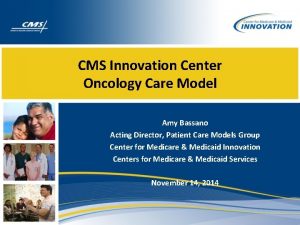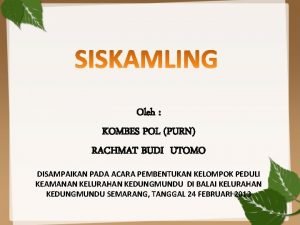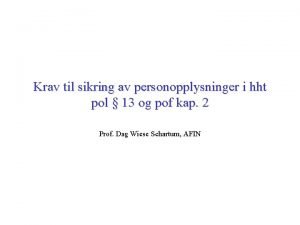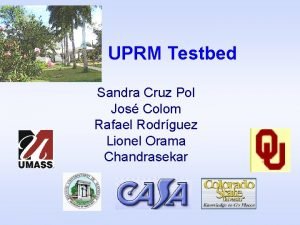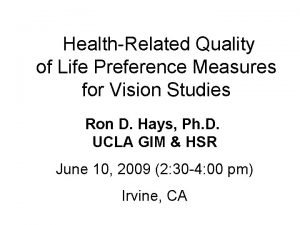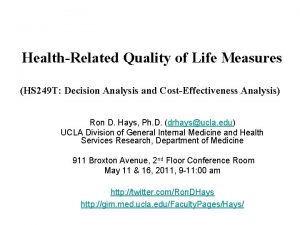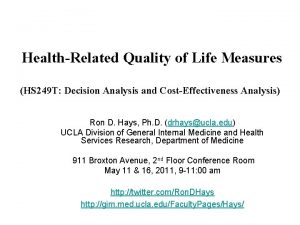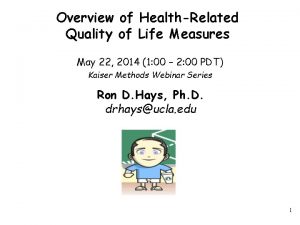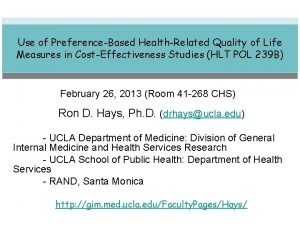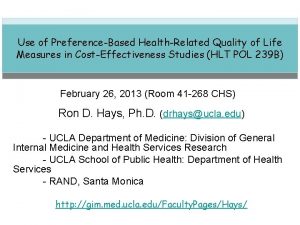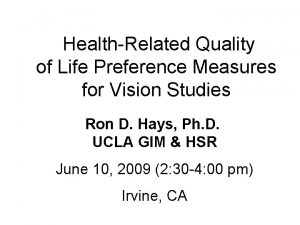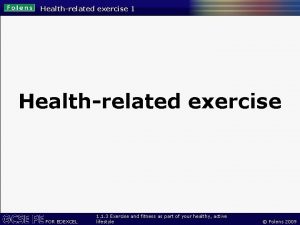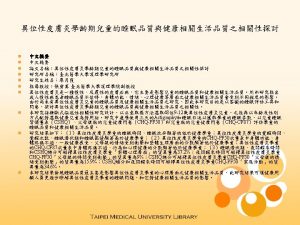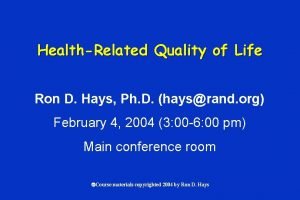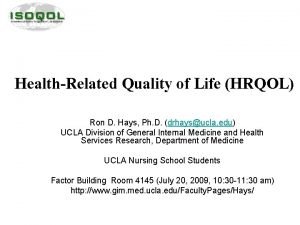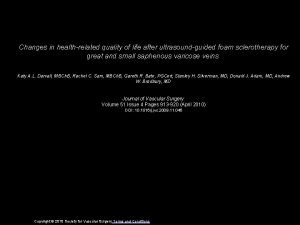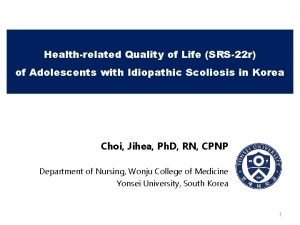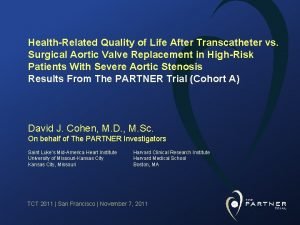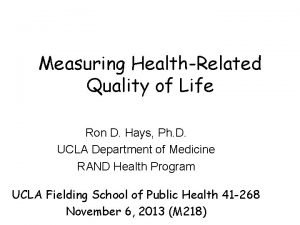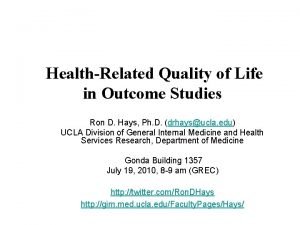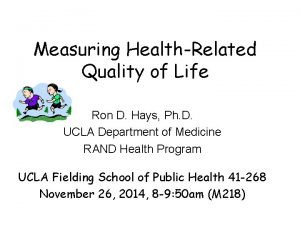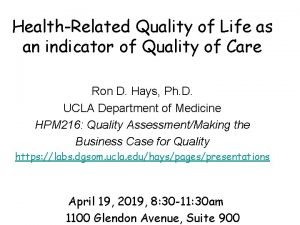HealthRelated Quality of Life Measures HLT POL 239


































- Slides: 34

Health-Related Quality of Life Measures (HLT POL 239 B) February 21, 2013 (Room 41 -268 CHS) Ron D. Hays, Ph. D. (drhays@ucla. edu) - UCLA Department of Medicine: Division of General Internal Medicine and Health Services Research - UCLA School of Public Health: Department of Health Services - RAND, Santa Monica http: //gim. med. ucla. edu/Faculty. Pages/Hays/

Patient-Reported Measures Technical Reports Demographics Quality of Care Behavior Health Clinical 2 Reports

Health-Related Quality of Life (HRQOL) is What you can do. • Functioning Self-care Role Social How you feel about your life. • Well-being Emotional well-being Pain Energy 3

Simplified HRQOL Framework General Health Social Support 4 Physical Health Physical Functioning Mental Health Depressive Symptoms Social Health Ability to Participate in Social Roles

SF-36® Generic Profile Measure • Functioning – Physical functioning (10 items) – Role limitations/physical (4 items) – Role limitations/emotional (3 items) – Social functioning (2 items) • Well-Being – Emotional well-being (5 items) – Energy/fatigue (4 items) – Pain (2 items) – General health perceptions (5 items) 5 5

Scoring HRQOL Profile Scales • Average or sum all items in the same scale. • Transform average or sum to • 0 (worse) to 100 (best) possible range • z-score (mean = 0, SD = 1) • T-score (mean = 50, SD = 10) 6 6

SF-36 PCS and MCS PCS_z = (PF_Z * (BP_Z * (EF_Z * (RE_Z * MCS_z = (PF_Z * (BP_Z * (EF_Z * (RE_Z * 7 0. 42) + 0. 32) + 0. 03) + -. 19) + -. 23) + -. 10) + 0. 24) + 0. 43) + (RP_Z * 0. 35) + (GH_Z * 0. 25) + (SF_Z * -. 01) + (EW_Z * -. 22) (RP_Z * -. 12) + (GH_Z * -. 02) + (SF_Z * 0. 27) + (EW_Z * 0. 49) PCS = (PCS_z*10) + 50 MCS = (MCS_z*10) + 50 7

Farivar et al. alternative weights PCS_z = (PF_z *. 20) + (RP_z *. 31) + (BP_z *. 23) + (GH_z *. 20) + (EF_z *. 13) + (SF_z *. 11) + (RE_z *. 03) + (EW_z * -. 03) MCS_z = (PF_z * -. 02) + (RP_z *. 03) + (BP_z *. 04) + (GH_z *. 10) + (EF_z *. 29) + (SF_z *. 14) + (RE_z *. 20) + (EW_z *. 35) • Farivar, S. S. , Cunningham, W. E. , & Hays, R. D. (2007). Correlated physical and mental health summary scores • for the SF-36 and SF-12 health survey, V. 1. Health and Quality of Life Outcomes, 5: 54. [PMCID: PMC 2065865] 8 8

Generic vs. Disease-Targeted ü In general, would you say your health is: Excellent/ Very good/ Good/ Fair/ Poor? ü How much does kidney disease bother you in your ability to work around the house? Not at all bothered/Somewhat bothered/ Moderately bothered/Very much bothered/ Extremely bothered 9 9

Reliability of measures 0. 0 (lowest) – 1. 0 (highest possible) 0. 80 for blood pressure and other clinical measures - 0. 70 -0. 90 for multi-item self-report measures Hahn, E. A. , Cella, D. , et al. (2007). Precision of health-related quality-of-life data compared with other clinical measures. Mayo Clin Proceedings, 82 (10), 1244 -1254. 10 10

SF-36 Physical Health Component Summary Score Predicts Mortality % dead 5 yrs. later (n=676) (n=754) (n=1181) (n=609) SF-36 Physical Health Component Score (PCS)—T score 11 Ware et al. (1994). SF-36 Physical and Mental Health Summary Scales: A User’s Manual. 11

Kidney Disease Quality of Life (KDQOLTM) Instrument v. Focus groups with patients and staff v. Pretests on small samples v. Field test with 165 persons with kidney disease at 9 dialysis centers v. Thousands of administrations since 12

Kidney Disease Quality of Life (KDQOL) Publications • Hays, R. D. , Kallich, J. D. , Mapes, D. L. , Coons, S. J. , & Carter, W. B. (1994). Development of the Kidney Disease Quality of Life (KDQOLTM) Instrument. Quality of Life Research, 3, 329 -338. • Edgell, E. T. , Coons, S. J. , Carter, W. B. , Kallich, J. D. , Mapes, D. , Damush, T. M. , & Hays, R. D. (1996). A review of health-related quality of life assessment in end-stage renal disease. Clinical Therapeutics, 18(5), 887 -938. • Rao, S. , Carter, W. B. , Mapes, D. L. , Kallich, J. D. , Kamberg, C. J. , Spritzer, K. L. , & Hays, R. D. (2000). Development of subscales from the symptom/problems and effects of kidney-disease items in the Kidney Disease Quality of Life (KDQOLTM) instrument. Clinical Therapeutics, 22, 1099 -1111. 13

KDQOL Targeted Domains (97 items and 43 items) v Symptoms/problems v Effects of kidney disease v Burden of kidney disease v v 34 12 20 8 4 4 Sleep Cognitive function Quality of social interaction Work status v Sexual function v Social support v Dialysis staff encouragement v Patient satisfaction 14 4 9 6 4 4 4 3 3 2 4 2 2 6 2 2 1

KDQOL-36 v Items 1 -12: SF-12 v Items 13 -16: Burden of Kidney Disease (4) v Items 17 -28: Symptoms/Problems (12) v Items 29 -36: Effects of Kidney Disease (8) Glover, C. et al. (2011). Understanding and assessing the impact of end-stage renal disease on quality of life: A systematic review of the content validity of selfadministered instruments used to assess health-related quality of life in end-stage renal disease. Patient, 4(1), 19 -30. 15

Burden of Kidney Disease • My kidney disease interferes too much with my life. • Too much of my time is spent deading with my kidney disease. • I feel frustrated with my kidney disease • I feel like a burden on my family. 16

Symptom/Problems-- To what extent were you bothered by. . . • • • 17 Soreness in your muscles? Chest pain? Cramps? Itchy skin? Dry skin? Shortness of breath? Faintness or dizziness? Lack of appetite? Washed our or drained? Numbness in hands or feet? Nausea or upset stomach? Problems with access (catheter) site?

Effects of Kidney Disease— How much does kidney disease bother you in … Fluid restrictions? Dietary restriction? Your ability to work around the house? Your ability to travel? Being dependent on doctors and other medical staff? • Stress or worries caused by kidney disease? • Your sex life? • Your personal appearance? • • • 18

Scoring v. Higher score = better health v. Transform linearly to 0 -100 range v. Average items in each scale together 19

KDQOL-36 Translations v Chinese v Czech v Danish v Dutch v English v French v German v Greek v Hebrew v Hungarian v Italian v Malay v Polish v Portuguese v Russian v Spanish v Swedish v Turkish http: //gim. med. ucla. edu/kdqol (register for downloads) 20

Dialysis Outcomes and Practice Patterns Study (DOPPS) • Longitudinal study of hemodialysis patients and unit practices – Goal is to identify practice patterns associated with improved patient outcomes • Uniform international data collection – Mortality – Health-related quality of life – Hospitalization – Vascular access • Coordinated by Arbor Research Collaborative for Health 21

DOPPS Data • 308 dialysis facilities in DOPPS I – 12, 465 patients from 7 countries – France, Germany, Italy, Japan, Spain, UK, US • 320 dialysis facilities in DOPPS II – 10, 551 patients from 12 countries – Same 7 above plus Australia, New Zealand, Belgium, Canada and Sweden • 297 facilities in DOPPS III – 9, 316 patients from the same 12 countries 22

KDQOLTM Scores Compared to National Sample of Patients Baseline 23 Follow-up Dialysis Outcomes and Practice Patterns Study (DOPPS) 55 -64 year old age group

24

Hemo. vs. Peritoneal Dialysis 90 80 70 60 50 HD 40 PD 30 20 10 0 25 Phy Func. Pain Effects Burden Work Fructuoso et al. Quality of Life in chronic kidney disease. Nefrologia, 2011, 31, 91 -96. Satisfaction

Future Directions in HRQOL http: //www. nihpromis. org/ • Item banks to assess HRQOL and allow for computer-adaptive testing (CAT) • Reliability = 1 – SE 2 = 0. 90 • SE = 3. 2 for T-score (mean= 50 & SD = 10). 26

Anger CAT 1 (In the past 7 days ) I was grouchy – Never – Rarely – Sometimes – Often – Always • Theta = 56. 1 SE = 5. 7 27

2 In the past 7 days … I felt like I was ready to explode – Never – Rarely – Sometimes – Often – Always • Theta = 51. 9 SE = 4. 8 28

3 In the past 7 days … I felt angry – Never – Rarely – Sometimes – Often – Always • Theta = 50. 5 SE = 3. 9 29

4 In the past 7 days … I felt angrier than I thought I should – Never – Rarely – Sometimes – Often – Always • Theta = 48. 8 SE = 3. 6 30

5 In the past 7 days … I felt annoyed – Never – Rarely – Sometimes – Often – Always • Theta = 50. 1 SE = 3. 2 31

6 In the past 7 days … I made myself angry about something just by thinking about it. – Never – Rarely – Sometimes – Often – Always • Theta = 50. 2 SE = 2. 8 32

Theta and SE estimates • • • 33 Item 1: 56 and Item 2: 52 and Item 3: 50 and Item 4: 49 and Item 5: 50 and Item 6: 50 and 6 5 4 4 3 <3

Thank you. http: //gim. med. ucla. edu/kdqol/ 34
 Immediate addressing mode in assembly language
Immediate addressing mode in assembly language Machine control instructions example
Machine control instructions example Hlt paper size
Hlt paper size Inverse composition rule
Inverse composition rule Repeated measures design vs independent measures design
Repeated measures design vs independent measures design Ap 239
Ap 239 Ap-239
Ap-239 Gradinita 239
Gradinita 239 Modern names
Modern names Hymn
Hymn Man power and reserve
Man power and reserve Gezang 239
Gezang 239 U-238 decay equation
U-238 decay equation Round 5 239 to 2 significant figures
Round 5 239 to 2 significant figures Iso 10303-239
Iso 10303-239 Non-zero digits are always
Non-zero digits are always What is 239 rounded to the nearest hundred
What is 239 rounded to the nearest hundred Ccbhc quality measures
Ccbhc quality measures Highmarl true performance quality measures
Highmarl true performance quality measures Oncology care model quality measures
Oncology care model quality measures Amy bassano
Amy bassano Pol sezan autoportret
Pol sezan autoportret Dva a pol chlapa zaujimavosti
Dva a pol chlapa zaujimavosti Bioloki
Bioloki Kombes pol budi utomo
Kombes pol budi utomo Pol pof
Pol pof Pol parol
Pol parol Asocijacije dzungla
Asocijacije dzungla Ustalanie wzoru rzeczywistego i empirycznego
Ustalanie wzoru rzeczywistego i empirycznego Pol pot
Pol pot Huzjak stjepan
Huzjak stjepan Ja som koza rohata do pol boka odrata
Ja som koza rohata do pol boka odrata Sandra cruz pol
Sandra cruz pol Freiluftanomalie
Freiluftanomalie Martine pol
Martine pol
